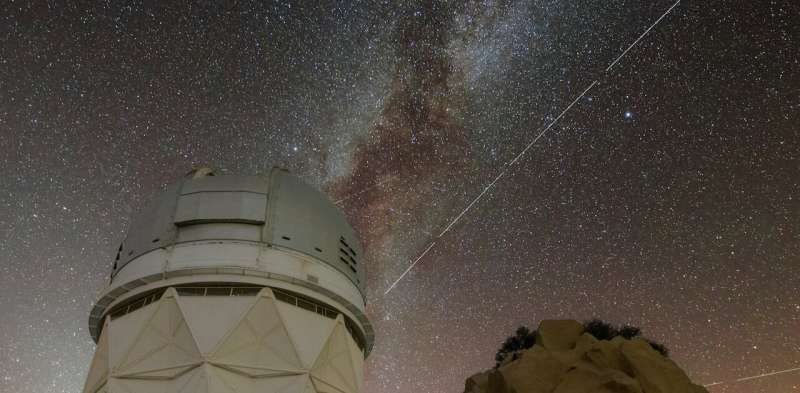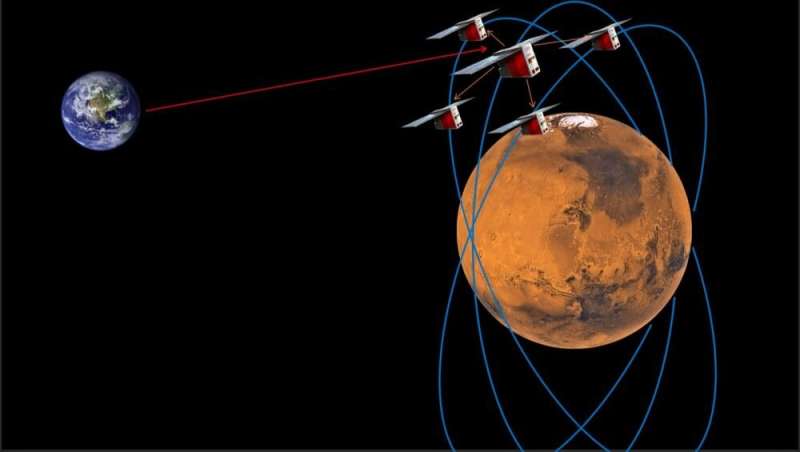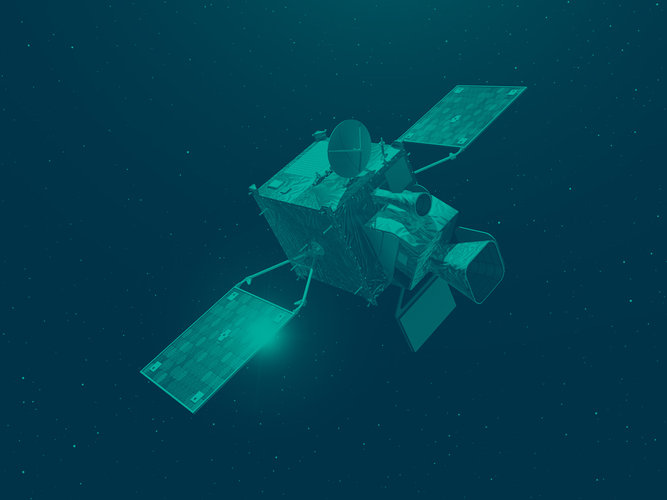
Copernical Team
Webb Space Telescope, Keck team up to study Saturn's moon Titan
 The James Webb Space Telescope (JWST) has turned its infrared cameras on Saturn's moon Titan, giving astronomers another eye on the largest and one of the most unusual moons in the solar system.
The only satellite with a dense atmosphere, it's also the only world besides Earth that has standing bodies of liquid on its surface, including rivers, lakes and seas - though the liquid is thought
The James Webb Space Telescope (JWST) has turned its infrared cameras on Saturn's moon Titan, giving astronomers another eye on the largest and one of the most unusual moons in the solar system.
The only satellite with a dense atmosphere, it's also the only world besides Earth that has standing bodies of liquid on its surface, including rivers, lakes and seas - though the liquid is thought NASA May Have Landed on a Martian Megatsunami Deposit Nearly 50 Years Ago
 When NASA's Viking 1 lander touched down on the surface of Mars nearly 50 years ago, its cameras imaged a boulder-strewn surface of elusive origin. New research led by Planetary Science Institute Senior Scientist Alexis Rodriguez shows the landing site may be on the margins of a megatsunami deposit, formed when a 3-kilometer asteroid impacted a northern Martian ocean about 3.4 billion years ago.
When NASA's Viking 1 lander touched down on the surface of Mars nearly 50 years ago, its cameras imaged a boulder-strewn surface of elusive origin. New research led by Planetary Science Institute Senior Scientist Alexis Rodriguez shows the landing site may be on the margins of a megatsunami deposit, formed when a 3-kilometer asteroid impacted a northern Martian ocean about 3.4 billion years ago. Analyzing the rhythmically layered bedrock above the marker band: Sols 3669-3670
 Curiosity drove ~25 meters back toward the Marker Band from our detour to the Gediz Vallis Ridge and has returned to the rhythmically layered bedrock we observed on Sols 3648-3649.
The first time Curiosity encountered these rocks we were unable to analyze them because one of the rover's wheels was perched on a rock. Now that we are parked safely, we will use a "Touch and Go" approach where
Curiosity drove ~25 meters back toward the Marker Band from our detour to the Gediz Vallis Ridge and has returned to the rhythmically layered bedrock we observed on Sols 3648-3649.
The first time Curiosity encountered these rocks we were unable to analyze them because one of the rover's wheels was perched on a rock. Now that we are parked safely, we will use a "Touch and Go" approach where NASA's Orion capsule performs burn to leave distant retrograde orbit
 NASA's Orion space capsule, which is in day 16 of its Artemis I test flight, completed a burn Thursday to take it out of distant retrograde orbit.
The burn, which was livestreamed by NASA, began about 4:53 p.m. EST and lasted for 1 minute, 45 seconds, and was successful.
The procedure involved firing engines on the European service module which commits the spacecraft to leaving t
NASA's Orion space capsule, which is in day 16 of its Artemis I test flight, completed a burn Thursday to take it out of distant retrograde orbit.
The burn, which was livestreamed by NASA, began about 4:53 p.m. EST and lasted for 1 minute, 45 seconds, and was successful.
The procedure involved firing engines on the European service module which commits the spacecraft to leaving t Extraterrestrial signal search is underway using the southern hemisphere's biggest radio telescope
 Breakthrough Listen has begun observations using a powerful new instrument deployed to the MeerKAT radio telescope in the remote Karoo region of South Africa. The new search for technosignatures - indicators of technology developed by extraterrestrial intelligence - expands the number of targets searched by a factor of 1,000.
The astronomers and engineers on the Breakthrough Listen team ha
Breakthrough Listen has begun observations using a powerful new instrument deployed to the MeerKAT radio telescope in the remote Karoo region of South Africa. The new search for technosignatures - indicators of technology developed by extraterrestrial intelligence - expands the number of targets searched by a factor of 1,000.
The astronomers and engineers on the Breakthrough Listen team ha BlueWalker 3, an enormous and bright communications satellite, is genuinely alarming astronomers

The night sky is a shared wilderness. On a dark night, away from the city lights, you can see the stars in the same way as your ancestors did centuries ago. You can see the Milky Way and the constellations associated with stories of mythical hunters, sisters and journeys.
But like any wilderness, the night sky can be polluted. Since Sputnik 1 in 1957, thousands of satellites and pieces of space junk have been launched into orbit.
For now, satellites crossing the night sky are largely a curiosity. But with the advent of satellite constellations—containing hundreds or thousands of satellites—this could change.
The recent launch of BlueWalker 3, a prototype for a satellite constellation, raises the prospect of bright satellites contaminating our night skies. At 64 square meters, it's the largest commercial communications satellite in low Earth orbit—and very bright.
Pollution of the night sky
With a small network of satellites around Mars, rovers could navigate autonomously

When it comes to "on the ground" exploration of Mars, rovers make pretty good advance scouts. From Pathfinder to Perseverance, we've watched as these semi-autonomous robots do what human explorers want to do in the future. Now, engineers are studying ways to expand rover exploration on Mars. One thing they're thinking about: communication satellite constellations for Mars surface navigation.
The current generation of Mars rovers landed in easily accessible places. Other Martian regions, such as the poles, or Valles Marineris, remain pretty much untouched. That's partly because they're difficult to reach and their weather conditions present challenges. The poles hold a lot of clues to the Martian climate system. Although one cap is known to be mostly water ice, both caps could contain (or be hiding) additional water either in underground lakes or frozen beneath the caps.
Meteosat Third Generation

Meteosat Third Generation
Renewed support for ESA innovation at Paris Ministerial
Member State delegations pledged a record-breaking €16.9 billion budget for ESA at last week's Council at Ministerial Level in Paris, including renewed support for dedicated R&D programmes employed by ESA’s Directorate of Technology, Engineering and Quality to invent the future in space.
SiriusXM commissions Maxar to build two satellites
 Maxar Technologies and SiriusXM (NASDAQ: SIRI) have announced a new agreement commissioning Maxar to build and deliver two new geostationary communications satellites for SiriusXM. The SXM-11 and -12 satellite orders increase the total number of spacecraft in development for SiriusXM by Maxar to four, following the 2021 agreement for the construction of SXM-9 and -10.
"This investment reaf
Maxar Technologies and SiriusXM (NASDAQ: SIRI) have announced a new agreement commissioning Maxar to build and deliver two new geostationary communications satellites for SiriusXM. The SXM-11 and -12 satellite orders increase the total number of spacecraft in development for SiriusXM by Maxar to four, following the 2021 agreement for the construction of SXM-9 and -10.
"This investment reaf 